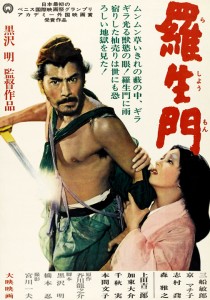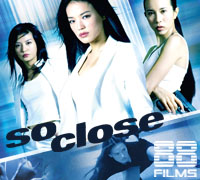AKA: In the Wood
Director: Akira Kurosawa
Producer: Jingo Minoura
Cast: Toshiro Mifune, Machiko Kyo, Masayuki Mori, Takashi Shimura, Minoru Chiaki, Kichijiro Ueda, Fumiko Honma
Running Time: 88 min.
By Alexander
The Good: I’ve never been as captivated by the cinematography of a black and white film as I was with this one. There are only three locales in the entire movie, yet each (particularly the rain-ravaged temple ruins) are perfectly lit and shot. The rain and dust and wind and the rare rays of the sun practically leap from the screen, no small feat considering the director’s/cinematographer’s palatte was “limited” to blacks, whites and various shades of gray. Also good: Kurosawa’s adaptation of a tale of murder and rape and the conflicting stories that follow is brilliant. Rashomon’s plot has been imitated countless times, yet never expressed as deftly and passionately.
The Bad: I know I’m supposed to like Rashomon. I mean, it’s directed by KUROSAWA. It has WEIGHTY themes, it’s BEAUTIFULLY shot and it has spawned dozens (if not hundreds) of imitators. Hell, it’s one of the best reviewed films OF ALL TIME. But so is Godfather, which bored me. Ditto for Citizen Kane. Despite the 88 minute running time Rashomon seemed a good half hour to an hour longer because of some unecessarily lengthy scenes (notably the frenzied and seemingly improvised-on-the-spot sword fight). At 60 to 70 minutes, this would have been taut and far more enjoyable, but I found myself growing bored — and then agitated — at the lingering shots of character faces and needlessly drawn-out duels.
The Ugly: The medium. Jesus, she’s hideous. I was expecting passion and drama, not HORROR. She’s like the precursor and inspiration for all those fucked-up, herky-jerky, blank-faced and pale “ghosts” or whatever they are in films like The Grudge and Ju-On. Also ugly: I took a course on the art and architecture of Japan in college, but I didn’t realize that the eyebrow-less women in Japanese art reflected an actual eyebrows plucked-bare look. Disconcerting. A mild bias, but it was jarring seeing the women characters with smudges of black on their foreheads instead of… well, eyebrows.
Alexander’s Rating: 7.5/10
By Shaolin Lord
Alfred Hitchcock once said that the perfection of his cinematic achievement in terms of reducing all that is unimportant and emphasizing on suspense would be a movie taking place in a phone booth with only two protagonists inside. This one here comes quite close.
If you start watching Akira Kurosawa’s movies, this is the one to begin with. It’s like nothing you have ever seen – not concentrating on fights like the majority of pre-80s Asian cinema, for example. This movie is totally psychological – forcing the viewer to speculate – due to the lack of proven facts. Having only a handful of characters to concentrate on, Kurosawa achieves the maximum amount of story development you could possibly have imagined.
The movie shows three main sceneries: the abandoned and ruined temple Rashomon, the woods nearby which bear the tale of the gruesome murder and the courthouse, where the witnesses are testified. You get the story told by the woodcutter (one of the three who seek refuge from the bad weather), the Samurai that has been killed (using a medium to let his soul speak), the killed man’s wife and the bandit Tajomaru, who is accused of the murder. The point of view changes in every story, thus letting lies enter each tale, making the development of the movie the more interesting to the viewer. The only clear fact seems to be the Samurai being dead. Apart from that, everything differs in the told stories, and it’s up the audience to decide which one is true.
Kurosawa does not need more than that to get his story moving. Plus, with Mifune as the bandit, what could ever go wrong? It is a poem, a very visual film with not much of a dialogue. His 1950-style special effects are completely delivered through camera-work, the visual effects showing the rain (which, by the way, looks like the definition of rain!!), the dashing trough the woods and the scenes being half covered by leafs are just superb. What makes this film so special are the multiple plot twists in the 4 told stories, the reception of the audience being the 5th tale, trying to filter the facts from the lies. In the end, the truth is not revealed, or at least seems to be hidden still, the message maybe the fact that to lie is human, or that every perception is different from person to person, or that people involved in an uncomfortable matter tend to try to alter the opinions of others.
It’s up to you to decide – if anything, it makes this movie even more of an outstanding one. Rashomon will get nothing but love from me, scoring a perfect ten.
Shaolin Lord’s Rating: 10/10




